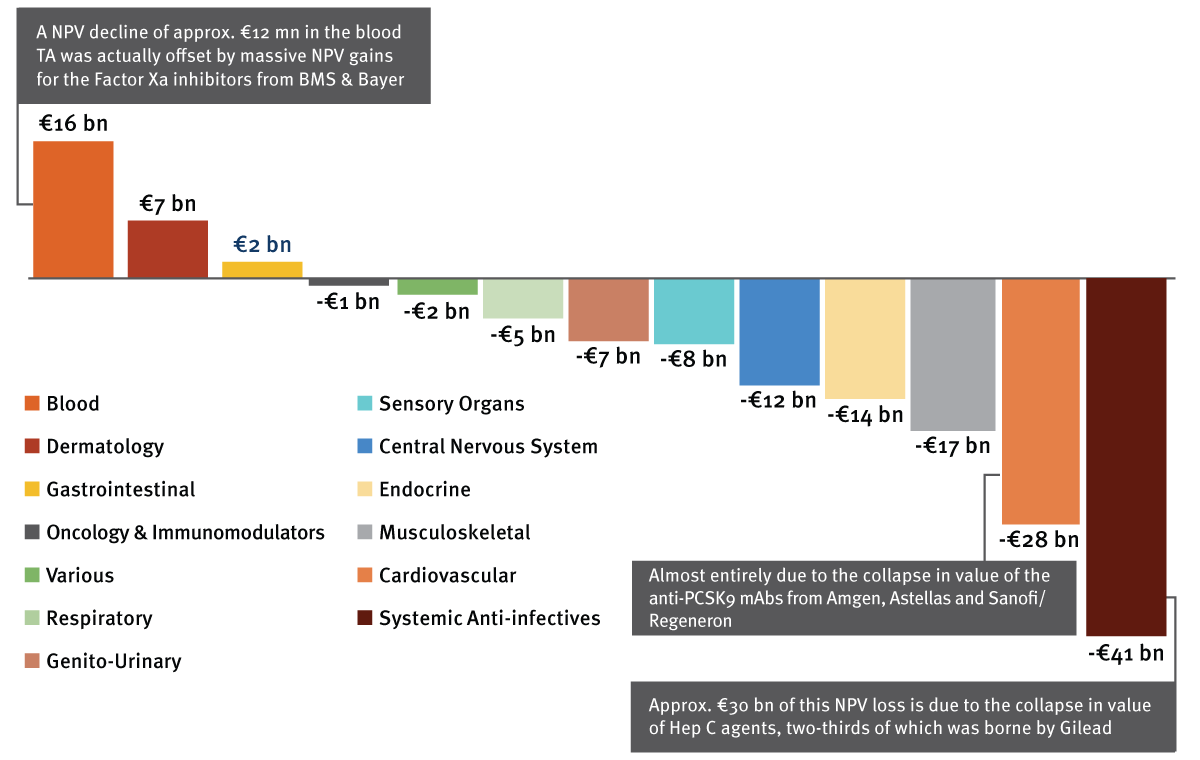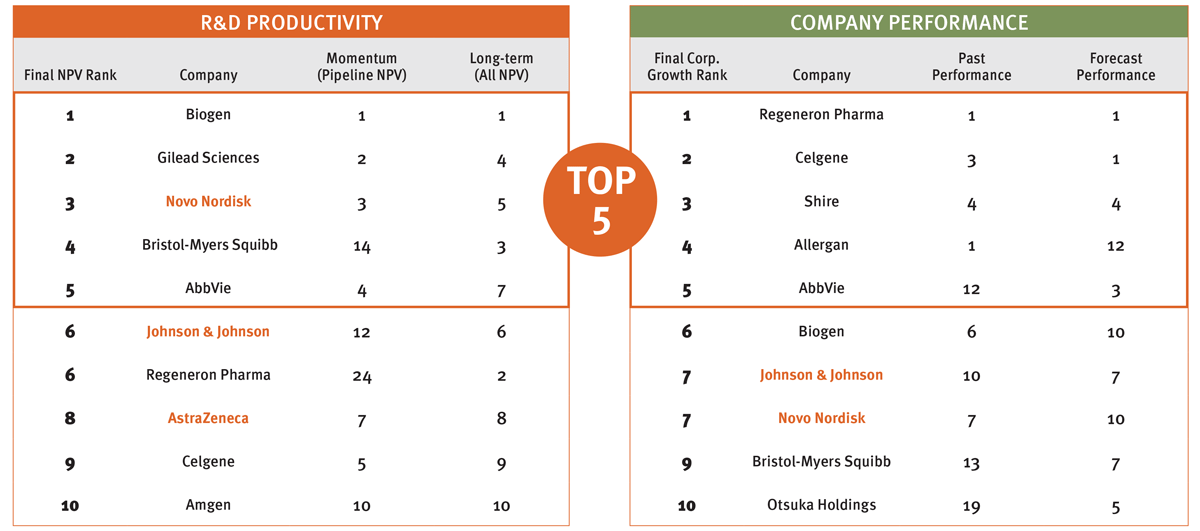Biopharma R&D Productivity And Growth 2017: Big Pharma Closes The Gap
Executive Summary
Catenion updates its annual list of the year's top pharma R&D performers. R&D productivity declined for the first time since 2014. Mid pharmas continue to dominate the top 10, but big pharmas are making inroads.
This is our fourth annual survey of pharma R&D productivity. Last year we noted that there has been a year-on-year increase in R&D productivity to the tune of 46% from 2014 to 2016. (Also see "Biopharma R&D Productivity And Growth 2016: Innovation Performance Improves" - In Vivo, 14 Dec, 2016.) However, this trend has not continued in 2017, where the overall R&D productivity of the top pharma companies has decreased by roughly 15%. The major driver of this is a decline in the metric that looks at pipeline value versus spending (momentum ranking), while the decrease in the metric that includes products launched within the last five years (long-term ranking) is relatively small by comparison. (See sidebar for a detailed description of the methodology.)
After years of growth, what has contributed to this decline in R&D productivity? To investigate, we looked at the eNPV (expected net present value) across all the different therapeutic areas and found them all to have declined or plateaud except dermatology and blood; the latter would have also have been negative if not for the dramatic upwards re-valuations of the Factor Xa anti-coagulants from Bristol-Myers Squibb Co. and Bayer AG. (See Exhibit 1.) Therefore, the decline was industry wide and perhaps a reflection of a relatively quiet year, with the vast array of immuno-oncology trials yet to read out and few groundbreaking results reported at major conferences. There were a few exceptions such as larotrectinib from Loxo Oncology Inc.showing impressive response data across many solid tumors, Johnson & Johnson’s Zytiga (abiraterone acetate) dramatically reducing the risk of death in prostate cancer and an IDO inhibitor from Incyte Corp.showing synergy with checkpoint inhibiting in some tumor types, all presented at the American Society of Clinical Oncology (ASCO) meeting.
Exhibit 1
2017 Change In eNPV By Therapeutic Area
Catenion
Nevertheless, the therapeutic areas that have declined the most this year are cardiovascular and anti-infectives. The former was almost entirely due to the collapse in value of the anti-PCSK9 mAbs from Amgen Inc., Astellas Pharma Inc.and Sanofi/Regeneron Pharmaceuticals Inc.due to poor sales and ongoing patent litigation. Whereas the latter was driven by nose-diving sales forecasts of hepatitis C drugs, which is paradoxically due to their own success. With cure rates of >95% for Gilead Sciences Inc.’s Harvoni (ledipasvir and sofosbuvir) in the more common hepatitis C sub-types, it's perhaps not surprising that the market of treatable patients is declining very rapidly. As scientific understanding marches on leading to companies developing “cures” as opposed to chronic treatments, they will have increasingly shorter sales horizons, shrinking patient pools and pricing pressures among other hurdles – dynamics that are already shaking up the industry.
Mid-pharma Still Leads, But The Gap Narrows
As has been the case since the inception of the R&D productivity ranking, mid-size pharmas continue to dominate, occupying seven of the top 10 spots. (See Exhibit 2). However, the distance between them and the rest continues to decrease year-on-year; indeed, the top performers were actually the major cause of the decrease of productivity this year. In comparison, the productivity of big pharma was flat overall as the large organizations better buffeted the volatility. One notable big pharma is AstraZeneca PLC, which has climbed to 8th place in the rankings this year on the back of approvals in the EU and China for Tagrisso (osimertinib), the EGFRT790M inhibitor, as well as label extensions for Lynparza (olaparib), the PARP inhibitor. In addition, the $1.6 billion deal of the latter with Merck & Co. Inc.for checkpoint combinations. Another continuously high-performing big pharma is J&J, which has consistently been in or around the top 10 over the past four years and lands in sxthh place this year.
The top 5 spots contain three firms from last year’s analysis with BMS and Celgene Corp. switching places into 4th and 10th, respectively, while Regeneron slipped to 6th (tying J&J), giving AbbVie Inc.a boost to 5th place. Outside of these, we also see Amgen slip into the 10th spot.
Exhibit 2 2017 R&D Productivity And Corporate Growth Ranking, Top 10 Companies
As of November 2017.
Big pharma (>40k employees 2016) highlighted in orange, final R&D productivity rank is generated by weighing all NPV 3/4 and Pipeline NPV metric 1/4, <3 pipeline NPVs available.
Catenion
Opposite Turning Points For BMS And Celgene?
Since 2014, BMS has slowly slid down the R&D productivity ranking despite having one of the industry’s most successful drugs in Opdivo (nivolumab). Its pipeline has contained no high-value assets since the nivolumab launch, leaving the company at the bottom of the momentum R&D ranking. However, this year could be a turning point as the early-stage pipeline has started to mature with several data readouts, in particular the LAG3 inhibitor, another promising checkpoint, and the IDO inhibitor – both in combination with nivolumab in solid tumors look intriguing. The net result is an increase in the BMS’ momentum R&D ranking to 14th place, still not stellar but perhaps the initiation of a comeback.
Celgene’s fortunes could not be more different. The company was the darling of Wall Street for some time, with the share price increasing about 300% since 2012, and not without merit, as Revlimid (lenalidomide) is one of the most successful drugs of all time. Indeed, we still see Celgene sitting in 2nd place in our corporate growth rankings. However, this year we see it in 9th position in R&D productivity down from 4th last year as the firm was hit by both commercial and clinical setbacks. The sales growth of its marketed PDE4 inhibitor, Otezla (apremilast), has been disappointing and Celgene discontinued the anti-sense oligonucleotide mongersen after a Phase III failure in Crohn's disease. This just leaves luspatercept and ozanimod as the main pipeline value drivers.
Gilead Maintains Momentum, Regeneron Slips
Our approach of scoring R&D productivity by both the pipeline assets (momentum ranking) and marketed assets launched in the last eight years (long-term ranking) sets a high performance bar. The ranking punishes companies that cannot replace already realized value through successful launches fast enough with a high value pipeline. This is exactly the situation Regeneron finds itself in after last year’s launch of Dupixent (dupilumab), its IL-4Rα mAb for atopic dermatitis. Regeneron has only a handful of assets remaining in Phase II onward after several trial failures this year, which are ascribed little value by analysts. The net result of this was for the firm to fall from the top spot in last year’s ranking to 6th this year. However, the company does have several NMEs in Phase I; will these deliver or will the firm have to resort to business development and licensing in the coming years? Despite this, in a similar manner to Celgene, the company maintains its place on the corporate growth ranking due to the strength of its marketed portfolio.
If we contrast this with Gilead, which moved up one place to the 2nd spot this year, it has been no secret in the industry that Gilead was in a similar position last year as Regeneron is now with a modestly valued pipeline; this was aggravated by the collapse in value of its hepatitis C franchise. In response to the pressure to replace lost revenue, Gilead made one of the largest acquisitions of the year in Kite Pharma Inc.for $11.9 billion, giving it the now marketed Yescarta (axicabtagene ciloleucel) anti-CD19 CAR-T, which has shown remarkable results in last-line non-Hodgkin’s lymphoma. [See Deal] However, it remains to be seen if this is sufficient to boost the firm’s prospects considering CAR-Ts are commercially unproven with well-known manufacturing and safety overhangs.
Nevertheless, Catenion has recently benchmarked the value created by firms through M&A and historically Gilead has been remarkably successful, creating around $32 billion of value (+171%) across seven acquisitions. This covers the acquisition of NeXstar Pharmaceuticals Inc.in 1999 all the way through to Pharmasset Inc.in 2012, which was subject to significant doom and gloom by analysts at the time due to the high price paid but now looks to be a great deal. Catenion will publish the full analysis in due course. So who would bet against Gilead making a success out of CAR-Ts?

